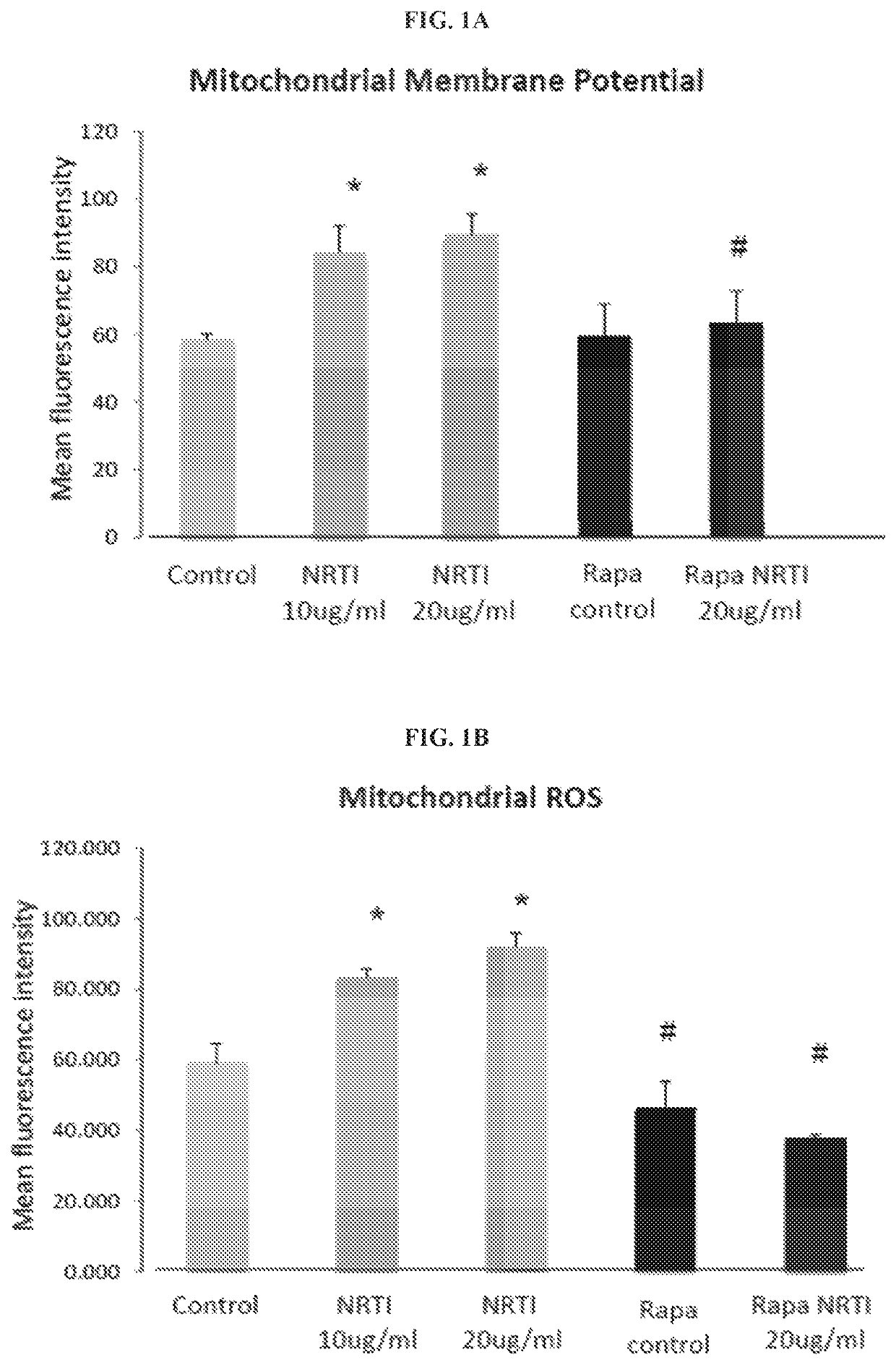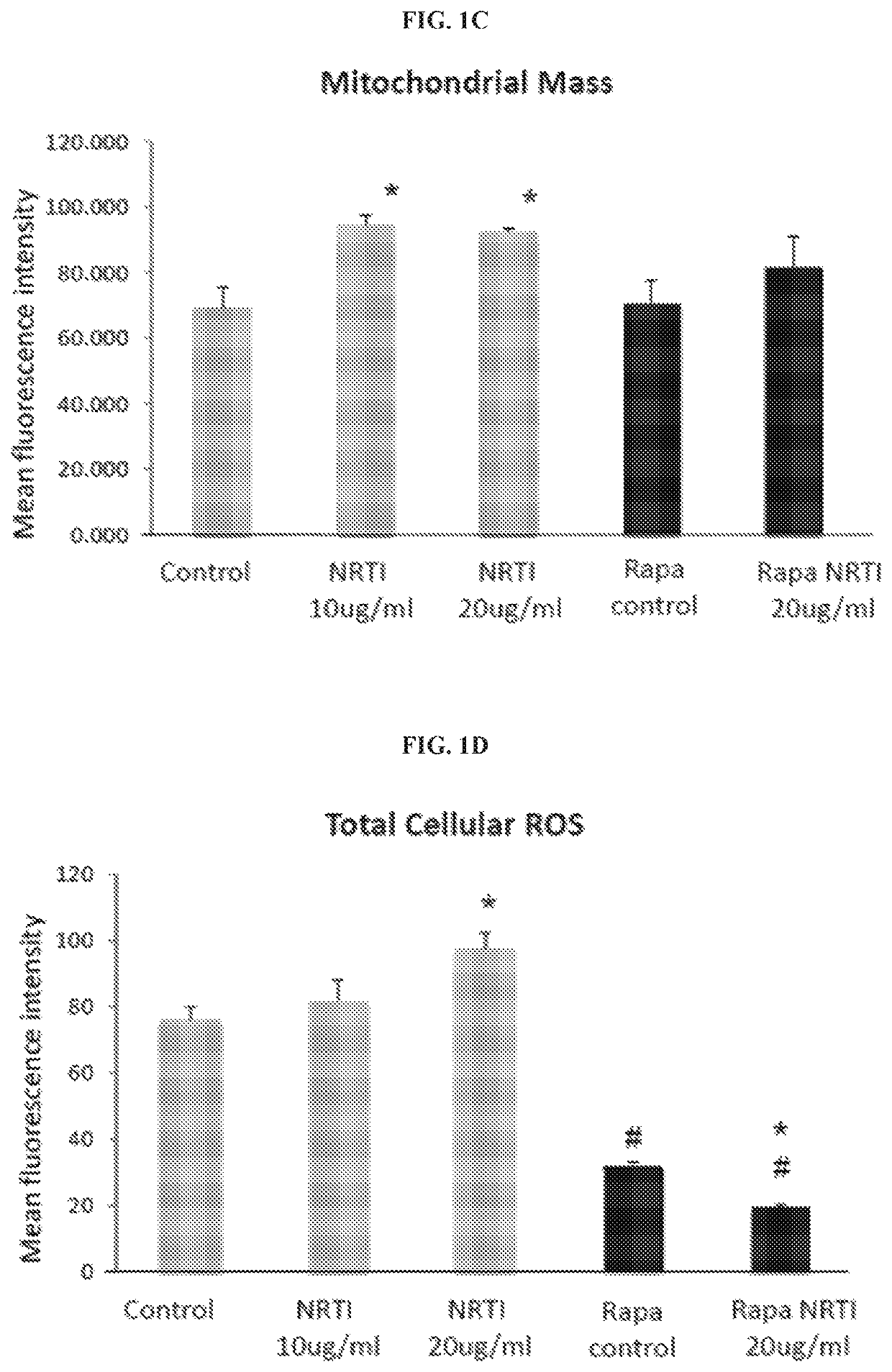Compositions and methods for treating or preventing dermal disorders
a technology for dermal disorders and compositions, applied in the field of compositions and methods for treating or preventing dermal disorders, can solve the problems of preventing the use of intravenous lines, increasing the fragility of skin, and major clinical problems of dermal atrophy, so as to prevent or minimize the senescence of mammalian fibroblasts, increase the lifespan of mammalian fibroblasts, and preserve cell organization
- Summary
- Abstract
- Description
- Claims
- Application Information
AI Technical Summary
Benefits of technology
Problems solved by technology
Method used
Image
Examples
example 1
rial Effects of Nucleoside / Nucleotide Analogs are Relieved by Rapamycin
[0191]The effects of combination treatment with TDF and FTC (referred to as NRTIs for simplicity) were examined at concentrations relevant to serum levels in patients receiving anti-retroviral therapy, on mitochondria in both human cardiac and lung fibroblasts. Parallel cultures were grown in the additional presence of 1 nM rapamycin. This concentration of rapamycin was found to extend replicative lifespan and improve the mitochondrial profile of human fibroblasts. Exposure to NRTIs for 7 days produced a significant increase in mitochondrial membrane potential, mitochondrial ROS production, and mitochondrial mass in the human cardiac fibroblasts (FIGS. 1A-1C). Similar results were observed in the human lung fibroblasts. Additionally, total cellular ROS increased significantly following exposure to NRTIs in both fibroblast populations (FIG. 1D). Cultures grown in the presence of rapamycin did not exhibit the same ...
example 2
ns in Electron Transport Chain Components in Response to Nucleoside / Nucleotide Analogs and Rapamycin
[0193]The effect of NRTI exposure on steady state levels of a subset of electron transport chain proteins was examined. Levels of NADH dehydrogenase (ubiquinone) 1 beta subcomplex, 8 (NDUFB8) of complex I, succinate dehydrogenase (ubiquinone) ironsulfur subunit (SDHB) of complex II, ubiquinol-cytochrome c reductase core protein II (UQCRC2) of complex III, and cytochrome c oxidase subunit I (mt-CO1) of complex IV all increased following exposure to NRTIs (FIG. 2A). Similarly, the steady state level of the outer membrane voltage dependent channel (VDAC) increased in cells exposed to NRTIs while in contrast, steady state levels of the ATP synthase alpha subunit 1 (ATP5A) were unchanged (FIG. 2A).
[0194]Cells treated with rapamycin expressed lower steady state levels of NDUFB8, SDHB, UQCRC2, and mt-CO1, while levels of ATP5A were similar to control cells. In addition, ETC protein levels we...
example 3
e Response to Mitochondrial Dysfunction and Protection by Rapamycin
[0197]Molecular markers of the senescence program were examined following exposure to NRTIs (FIGS. 3A-3F). Levels of p53, p21, and p16 increased in fibroblasts exposed to NRTIs, while in rapamycin treated cells the levels of these senescence associated proteins did not increase (FIG. 3A). In addition, levels of lamin B1, which is known to decrease during senescence, decreased in cells exposed to NRTIs. Rapamycin prevented this decrease (FIG. 3A). Additionally, intracellular levels of IL-6, which is a component of the senescence associated secretory program, increased following exposure to NRTIs. Consistent with a block in the senescence program, rapamycin treated cells showed no increase in the levels of IL-6 following exposure to NRTIs (FIG. 3A). The percentage of the cell population expressing the senescence marker, senescence associated β-galactosidase (SA-β-gal) following exposure to NRTIs was examined. A dose de...
PUM
| Property | Measurement | Unit |
|---|---|---|
| thickness | aaaaa | aaaaa |
| w/w | aaaaa | aaaaa |
| time | aaaaa | aaaaa |
Abstract
Description
Claims
Application Information
 Login to View More
Login to View More - R&D
- Intellectual Property
- Life Sciences
- Materials
- Tech Scout
- Unparalleled Data Quality
- Higher Quality Content
- 60% Fewer Hallucinations
Browse by: Latest US Patents, China's latest patents, Technical Efficacy Thesaurus, Application Domain, Technology Topic, Popular Technical Reports.
© 2025 PatSnap. All rights reserved.Legal|Privacy policy|Modern Slavery Act Transparency Statement|Sitemap|About US| Contact US: help@patsnap.com



